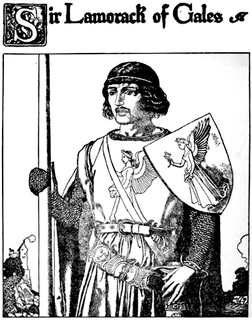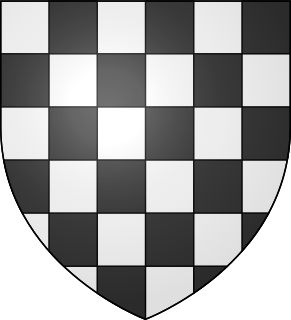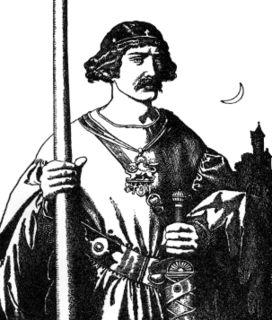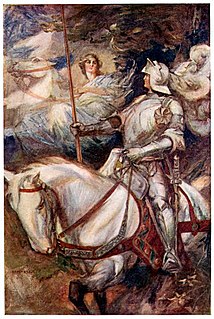This article needs additional citations for verification .(May 2018) (Learn how and when to remove this template message) |
Sir Hector de Maris (or Ector de Maris) is a Knight of the Round Table in Arthurian legend (he should not be mistaken with Sir Ector, the father of Sir Kay and foster father of Arthur). Hector is the younger half-brother of Lancelot and the natural son of King Ban of Benwick and the Lady de Maris; Sir Bors and Sir Lionel are his cousins.
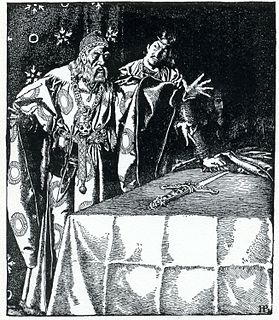
Sir Ector, sometimes Hector, Antor, or Ectorius, is the father of Sir Kay and the adoptive father of King Arthur in the Matter of Britain. Sometimes portrayed as a king instead of merely a lord, he has an estate in the country as well as properties in London.

In Arthurian legend, Sir Kay is King Arthur's foster brother and later seneschal, as well as one of the first Knights of the Round Table. In later literature he is known for his acid tongue and bullying, boorish behavior, but in earlier accounts he was one of Arthur's premier warriors. Along with Bedivere, with whom he is frequently associated, Kay is one of the earliest characters associated with Arthur. Kay's father is called Ector in later literature, but the Welsh accounts name him as Cynyr Ceinfarfog.

King Arthur was a legendary British leader who, according to medieval histories and romances, led the defence of Britain against Saxon invaders in the late 5th and early 6th centuries. The details of Arthur's story are mainly composed of folklore and literary invention, and his historical existence is debated and disputed by modern historians. The sparse historical background of Arthur is gleaned from various sources, including the Annales Cambriae, the Historia Brittonum, and the writings of Gildas. Arthur's name also occurs in early poetic sources such as Y Gododdin.
Hector de Maris participates in the Grail Quest, but he is one of the many knights who prove unworthy of achieving the object. In the Quest du Saint Graal of the Vulgate Cycle, Hector and Gawain are traveling together when they come to a ruined chapel where they pass the night. Each has a marvelous dream. The next morning, as they are telling each other their respective visions, they see, "a Hand, showing unto the elbow, and was covered with red samite, and upon that hung a bridle, not rich, and held within the fist a great candle that burnt right clear, and so passed afore them, and entered into the Chapel, and then vanished away, and they wist not where." Jessie Weston found this an "unintelligent" variation on the theme of the perilous Black Hand in other romances in the Grail Cycle.
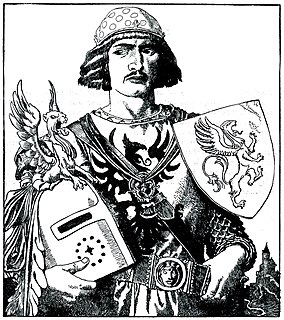
Gawain, also known as Gawaine or Gauwaine, among various other forms and spellings, is King Arthur's nephew and a Knight of the Round Table in the Arthurian legend. Under the name Gwalchmei, he appears very early in the legend's development, being mentioned in some of the earliest Welsh Arthurian sources. As Gawain, he appears in Latin, French, English, Dutch, German and Italian literature, notably as the protagonist of the story of Sir Gawain and the Green Knight. Other tales of Gawain include Historia Regum Britanniae, Roman de Brut, De Ortu Waluuanii, Diu Crône, The Awntyrs off Arthure, Le Chevalier à l'épée, and The Weddynge of Syr Gawen and Dame Ragnell, as well as the works of Chrétien de Troyes and the prose cycle Lancelot-Grail.
Jessie Laidlay Weston was an English independent scholar, medievalist and folklorist, working mainly on mediaeval Arthurian texts.

The Holy Grail is a treasure that serves as an important motif in Arthurian literature. Different traditions describe it as a cup, dish or stone with miraculous powers that provide happiness, eternal youth or sustenance in infinite abundance, often in the custody of the Fisher King. The term "holy grail" is often used to denote an elusive object or goal that is sought after for its great significance.
Hector's adventures in the name of King Arthur were many and wide-ranging. With Sir Morganore, it was Hector de Maris who welcomed Sir Tristan to Camelot when he was shipwrecked nearby. The two jousted in a friendly competition, but Hector was ashamed to have been beaten by a knight of Cornwall. Other times he was more successful at tournaments, getting the better of both Sirs Palomides and Percivale. He, however, failed to defeat Sir Turquine and became one of the knights he imprisoned before being rescued by his brother, Sir Lancelot. He returned the favour by rediscovering the lost Knight of the Lake after his period of insanity and returning him to Court.

Tristan, also known as Tristram or Tristain, is a knight of the Round Table in Arthurian legend and the hero of the Tristan and Iseult story.

Camelot is a castle and court associated with the legendary King Arthur. Absent in the early Arthurian material, Camelot first appeared in 12th-century French romances and, after the Lancelot-Grail cycle, eventually came to be described as the fantastic capital of Arthur's realm and a symbol of the Arthurian world.

Cornwall is a county in South West England in the United Kingdom. The county is bordered to the north and west by the Celtic Sea, to the south by the English Channel, and to the east by the county of Devon, over the River Tamar which forms most of the border between them. Cornwall forms the westernmost part of the South West Peninsula of the island of Great Britain. The furthest southwestern point of Great Britain is Land's End; the southernmost point is Lizard Point. Cornwall has a population of 563,600 and covers an area of 3,563 km2 (1,376 sq mi). The county has been administered since 2009 by the unitary authority, Cornwall Council. The ceremonial county of Cornwall also includes the Isles of Scilly, which are administered separately. The administrative centre of Cornwall, and its only city, is Truro.
He is known to have had a long relationship with Lady Perse of the Narrow Borderland, whose fiancé he murdered in order to be with her. Hector later had an affair with the cousin of the Lady of Roestoc, before being reunited with Perse.
When Lancelot is caught in his affair with Guinevere, Hector stands by his brother and leaves court with him. He becomes one of Lancelot's top generals, participating in the battle to rescue the queen at her execution, and the defense of Joyous Guard. Like all his family, he joins Lancelot in France when they are expelled from Arthur's kingdom, and he helps defeat the army led by Mordred's sons after the Battle of Camlann. He was the last knight to join his brother at the Archbishop of Canterbury's hermitage and apparently died there before the others left on crusade.

Guinevere, often written as Guenevere or Guenever, is the wife and queen of King Arthur in the Arthurian legend. Guinevere has been portrayed as everything from a villainous and opportunistic traitor to a fatally flawed but noble and virtuous lady. She has first appeared in Geoffrey of Monmouth's Historia Regum Britanniae, a pseudo-historical chronicle of British history written in the early 12th century, and continues to be a popular character in the modern adaptations of the legend.

Mordred or Modred is a character who is variously portrayed in the Arthurian legend. The earliest known mention of a possibly historical Medraut is in the Welsh chronicle Annales Cambriae, wherein he and Arthur are ambiguously associated with the Battle of Camlann in a brief entry for the year 537. His figure seemed to have been regarded positively in the Welsh tradition and may have been related to that of Arthur's son.
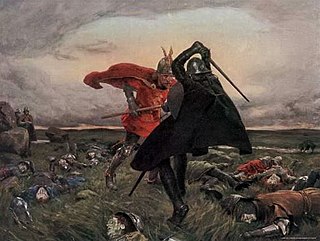
The Battle of Camlann is reputed to have been the final battle of King Arthur during the early 6th century, in which he either died or was fatally wounded, fighting either with or against Mordred who is also said to have died. Its depictions in the medieval legend of Arthur are generally based on that in the pseudo-chronicle Historia Regum Britanniae. These variants include the later chivalric romance tradition, with the version included in Le Morte d'Arthur being popular today.




